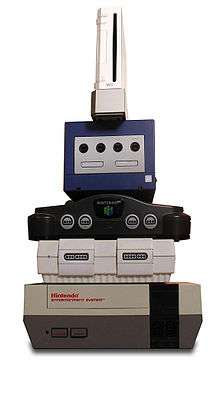PICA200
PICA200 is a graphics processing unit (GPU) for embedded devices designed by Digital Media Professionals Inc. (DMP), a Japanese GPU design company. It was announced at SIGGRAPH 2005, and presented at a SIGGRAPH 2006 conference. PICA is DMP's brand of graphics processors for embedded devices, scalable from portables up to high-performance arcade systems. PICA200 simply denotes a 200 MHz-clocked GPU from the PICA family.
PICA200 has an instruction-programmable core (IPC) that gives it the capability to change configuration based on demands for a specific target system, which it manages with its 3D graphics engine. PICA200 supports second-generation DMPs proprietary MAESTRO graphics technology ("MAESTRO-2G") which includes OpenGL ES 1.1 API support, optional OpenGL ES 1.1 extensions pack and some DMP proprietary extensions which enable custom hardware-based shading algorithms such as procedural texturing,[1] bidirectional reflectance distribution function (BRDF), Cook-Torrance specular highlights, polygon subdivision ("Geo Shader", a.k.a. tessellation),[2] soft shadow projection and fake subsurface scattering [3] (similar to two-sided lighting).[4]
The 3D processing core of PICA200 consists of up to four programmable vertex pipelines that can be rearranged as four pixel pipelines. The number of IPCs and pipelines will depend on the target processor core and may change in the future.[5]
For 2D graphics rendering there are two optional add-ons:[5] the image post-processing module PICA-FBM ("Frame Buffer Object") that can be used as an anti-aliasing filter with support for some specific 2D functions and the vector graphics module PICA-VG ("Vector Graphics") as PICA-FBM extension.
PICA-FBM is also available as a standalone 2D graphics core. PICA-VG is a PICA-FBM are only available as optional addons.[5]
PICA-VG also supports released Khronos OpenVG 1.0 API, released on July 18, 2005[6] which give it additional potential for vector graphics acceleration.[5]
PICA200 and MAESTRO-2G is a further refinement of DMP's first-generation MAESTRO developed in DMP's proof-of-concept processor ULTRAY2000.
Applications
DMP announced that Nintendo adopted PICA200 as the GPU for the portable game console Nintendo 3DS.[7]
Specification
- 65 nm Single Core[8](max. clock frequency 400 MHz)
- Power consumption: 0.5-1.0 mW/MHz[2]
- Frame Buffer max. 4095×4095 pixels
- Supported pixel formats: RGBA 4-4-4-4, RGB 5-6-5, RGBA 5-5-5-1, RGBA 8-8-8-8
- Vertex program (ARB_vertex_program)
- Render to Texture
- Hardware Transform and Lighting(T&L)
- MipMap
- Bilinear texture filtering
- Alpha blending
- Full-scene anti-aliasing (2×2)
- Phong Shading
- Cel Shading
- Perspective-Correct Texture Mapping
- Dot3 Bump Mapping/Normal Mapping.
- Shadow Mapping
- Shadow Volumes
- Self-Shadowing
- Lightmapping
- Environment Mapping/Reflection Mapping
- Volumetric Fog[9]
- Post-processing effects like motion, bloom, depth of field, HDR rendering, gamma correction
- Polygon offset
- Depth Test, Stencil Test, Alpha Test.
- Clipping, Culling
- 8-bit stencil buffer
- 24-bit depth buffer
- Single/Double/Triple buffer
- 5-Stage TEV Pipeline
- TEV Combiner Buffer(Only the first four TEV stages can write to the combiner buffer)
- Color Combiners, Alpha Combiners, Texture Combiners.
- PICA-FBM frame buffer management
- DMP's MAESTRO-2G technology:
- per-pixel lighting
- fake sub-surface scattering
- procedural texture
- refraction mapping
- subdivision primitive
- shadow
- gaseous object rendering
- bidirectional reflectance distribution function
- Cook-Torrance Model
- polygon subdivision
- soft shadowing
References
- "Procedural texture generation unit and saving video memory". August 15, 2006. Archived from the original on August 26, 2010. Retrieved August 26, 2010.
- "[Page64] DMP Inc. PICA graphics core" (PDF). EuroGraphics 2008, Crete. April 14–18, 2008.
- "K. Kolchin, CURVATURE BASED RENDERING METHOD AND DEVICE FOR TRANSLUCENT MATERIALS SUCH AS SKIN OF HUMAN BODY, JP2008250577 (A)". October 16, 2008.
- "Simon Green, GPU Gems 2, Chapter 16. Real-Time Approximations to Subsurface Scattering". August 15, 2006.
- "PICA200's OpenGL ES 1.1 support, core programming and optional addon modules". August 15, 2006. Archived from the original on August 26, 2010.
- "OpenVG specification" (PDF). July 28, 2005. Archived from the original (PDF) on July 12, 2011. Retrieved January 11, 2011.
- "Press Release: DMP 3D Graphics IP core "PICA200" is adopted by Nintendo 3DS". Digital Media Professionals Inc. (DMP). June 21, 2010. Archived from the original on September 20, 2010. [html] Archived 2010-08-25 at the Wayback Machine [pdf] Archived 2010-09-20 at the Wayback Machine
- "PICA 200 3D Graphics IP (product brochure)" (PDF). Digital Media Professionals Inc. (DMP). June 11, 2010. Archived from the original (PDF) on July 4, 2010.
- "Archived copy". Archived from the original on 2017-10-16. Retrieved 2016-01-29.CS1 maint: archived copy as title (link)
